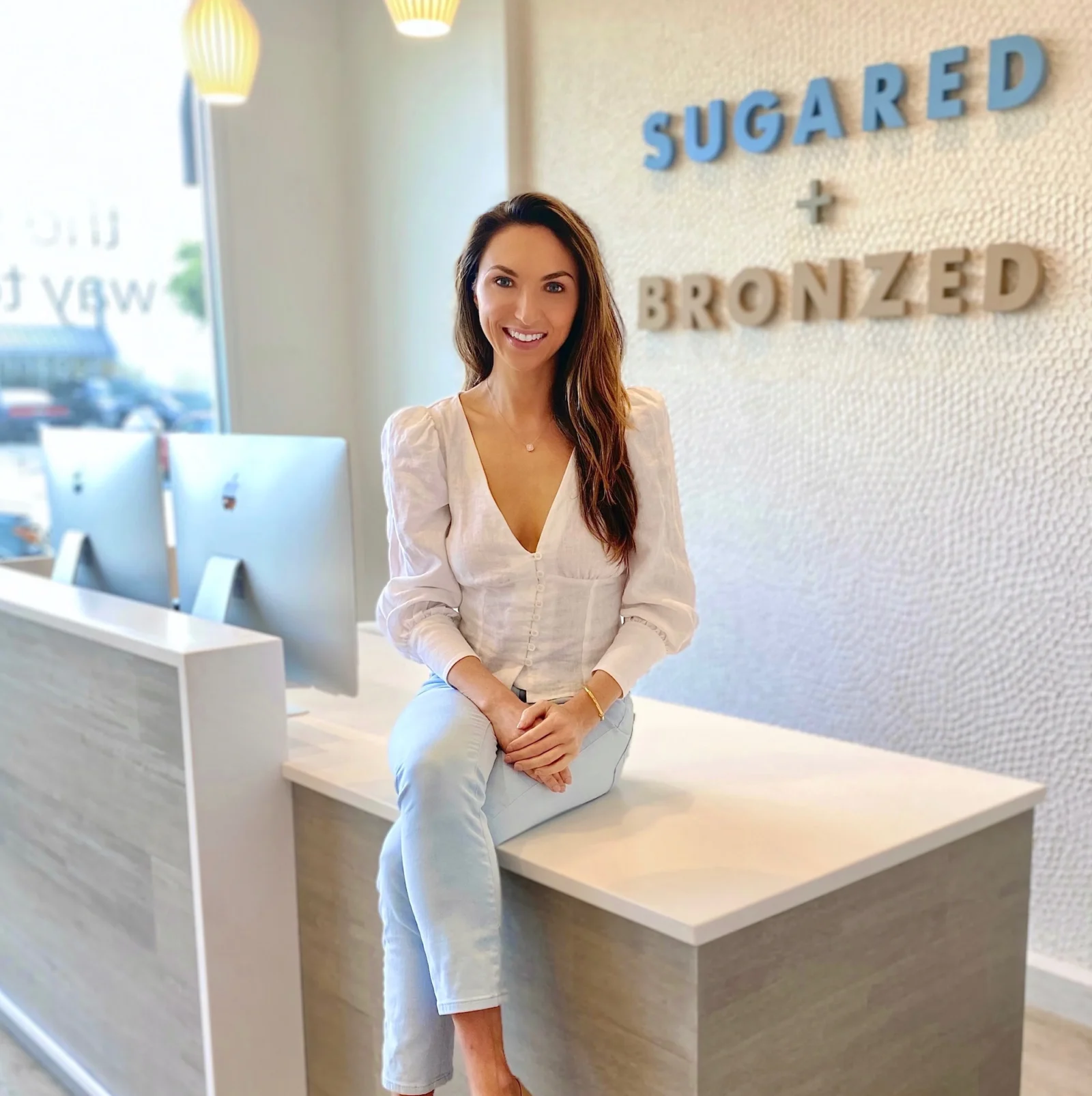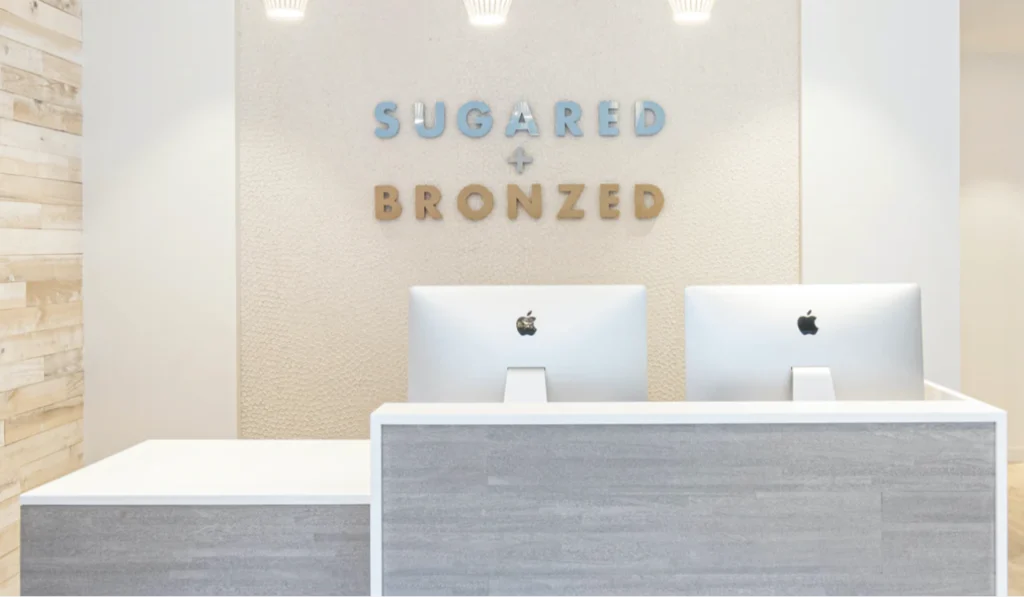CEO Corner: How Courtney Claghorn Grew Sugared + Bronzed Into a Winner

Claghorn started Sugared + Bronzed with just $500, growing it into the nation’s largest sugaring hair removal and sunless tanning destination
Courtney Claghorn founded Sugared + Bronzed when she was just 23, frustrated by the lack of affordable spray tanning services available in Santa Monica. Today, the company is the nation’s largest sugaring hair removal and sunless airbrush spray tan destination, with locations in California, New York, Pennsylvania and Texas.
With the harmful effects of sun tanning being taken more seriously than ever by consumers, Sugared + Bronzed offers spray tans with all-natural ingredients. Its sugaring services are similarly made with just sugar, lemon, and water, and are less abrasive than waxing.
Athletech News spoke with Claghorn about her inspiration for founding the company, and why (and where) Sugared + Bronzed is expanding so rapidly.
The following conversation has been lightly edited for clarity and length.
Athletech News: What gap did you see in the market that prompted you to create Sugared + Bronzed?
Courtney Claghorn: We’re often asked, “How long have you had your business?” Well, we’re not one of those startups that happened overnight. I was 23. I founded it with my then-boyfriend, now husband. I was broke and always got spray tans. Back in college, in Boulder (Colorado), it was $30 for a spray tan, something I could afford. When I moved to Santa Monica for my first job in 2010, the prices skyrocketed to $75. This was in 2010. Imagine factoring in inflation post-COVID. I’d come home and complain to my boyfriend about it. We saw that as the gap in the marketplace. My boyfriend suggested, “You can probably learn how to do this.” I wasn’t skilled in makeup or hair, but he believed I could figure it out. That’s how the idea of starting a business with a nice experience at a reasonable price point began. One thing led to another, and he convinced me that we should each put in $500. That’s how it started, and I was really scared because I had just saved my first $500. By early 2011, I quit my job, started looking for our first store, and moved in, after very basic construction, by Memorial Day of 2011.
ATN: Was price point your major differentiator when you started marketing your business and growing it?
CC: Certainly, the price point was crucial, especially in digital advertising. But our number one source of new clients six months into the business, and still currently, is referrals. So, we knew that the price might intrigue someone but then it had to be the experience. We really wanted it to be a place where people felt comfortable, like they were hanging out with their girlfriends. Our clientele is 90 percent female. We wanted to create a place where you didn’t feel uncomfortable getting naked and where someone could chat with you and make you forget about what was going on.
In the early years, it was only tanning. Sugaring came a bit later, but it really followed the same concept. We asked ourselves, “How do we make this something where people are looking forward to it?”

ATN: Why did you add sugaring to your services?
CC: It was really multifactorial. In our first spot, we rented out the back of a store to someone who did sugaring and we just felt like there was a lot of synergy there. People were also coming into my apartment telling me that they were getting sugared or waxed right beforehand. I thought, that’s funny they’re basically getting naked at one place, getting dressed and coming back. Spray tanning also has a little bit more seasonality while sugaring is more consistent. The appointment times are the same, so for the client, it made so much sense that it just felt like a win-win. On top of that, it even made the real estate hunt a little bit easier, since we didn’t have to find such small places anymore.
ATN: What are the biggest challenges you’re facing right now as a company and how are you overcoming them?
CC: Real estate. It’s finding the right neighborhood. We want to find properties that are very accessible to consumers and visible in the street, but are not an insane rent deal where we have to raise our prices to do construction. We have the most amazing design and development team but there are always unforeseen construction and city permitting issues. These things are always out of our control; as much as we want to hit a certain number of openings, we have to give ourselves some grace.
With the industry, it’s a lot about education, particularly with sugaring. There are a lot of areas that really haven’t experienced sugaring. The education is also around making sure you come in with your hair the right length, because if you shaved 10 days ago and you come in, it will not be an ideal length. It’s really about getting that information to consumers the best we can. We also have a high standard for our employees and want to ensure that people who had an experience with someone who casually learned sugaring is not going to have the same experience with our employees. It’s hard to encourage someone who had a bad experience to try it again as we enter new markets.

ATN: How do you approach customer service in such a client-focused business?
CC: We’ve always used bigger brands and what we love from them. So it was always Nordstrom with customer experience. Our VP of Operations has come from 13 years at Nordstrom, which is just such a great, serendipitous fit. We really try to go above and beyond and really focus our training on putting the client first. If they come in and they don’t have the right amount of hair growth, we take that as our fault. We always take the blame and then try to facilitate what’s easiest for them. The experience has to be really tailored to that person, what their schedule looks like and what they’re willing to do, and that can be tough. It can be tough if someone comes in with a sunburn and they want to spray tan. That’s the one time we absolutely can’t spray tan because it will start peeling.
ATN: As you look to expand, how do you select new Sugared + Bronzed locations?
CC: In current markets, it’s a little bit easier. Using our client data is key. That’s why we just like when people come in, we ask what zip code they’re coming from. We care about if they’re making a long trek so we can serve them closer to their home or place of work. We also look at e-commerce data in certain cities. We use Buxton, a real estate data platform, which is really helpful in terms of understanding the demographics of cities and density.
But gut instinct is a big part of it. Numbers can look perfect on a piece of paper, but sometimes a location doesn’t feel right. We also always listen to our clients, through sending out surveys or Instagram contests. We have Houston coming up as our next newest market and then Miami will follow that, so we’re working on construction in those cities next. What will follow that is really still a big internal debate right now.



